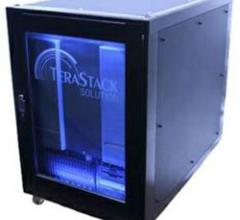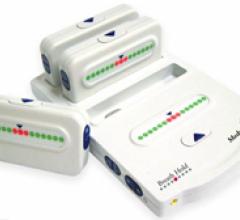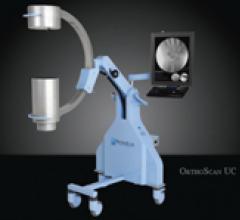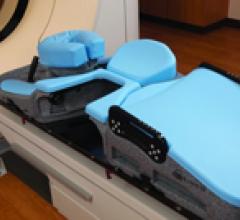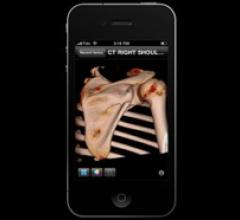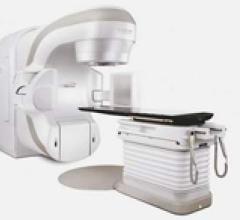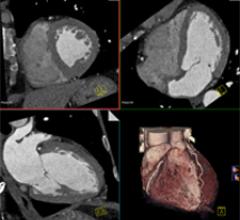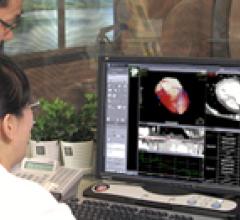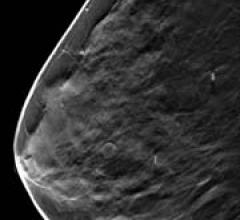September 30, 2011 – Siemens Healthcare returns to the Annual Meeting of the American Society for Radiation Oncology (ASTRO), Oct. 2-6 in Miami, with a broad range of solutions that multiply chances – for life. At this year’s booth (#203), Siemens will demonstrate its strong commitment to battling cancer with a portfolio that covers the spectrum of oncology care, with a particularly strong focus on diagnostic oncology imaging in in-room and outside-the-room imaging as well as in radiation therapy.
September 30, 2011 – The Molecular Imaging Biomarker Research Group of Siemens Medical Solutions recently completed a Phase II multi-center clinical trial of its HX4 positron emission tomography (PET) imaging biomarker, which is designed to detect hypoxia – a reduction in tissue oxygen levels – in solid tumors. The trial’s primary objective was to test the reproducibility of HX4’s uptake in tumors by conducting PET/computed tomography (CT) scans of the same patient on sequential days in a test-retest protocol. The trial enrolled 40 patients with head and neck, lung, liver, rectal or cervical cancers, who were scheduled to receive chemotherapy, radiation therapy or a combination of the two.
September 30, 2011 – ViewRay Inc. will present potential applications for magnetic resonance imaging (MRI)-guided radiotherapy at the annual meeting of the American Society for Radiation Oncology (ASTRO) Oct. 2-4 in Miami Beach, Fla., with software demonstrations in booth #865. The company's new research radiation therapy system is being developed to feature a patented combination of radiotherapy delivery and simultaneous magnetic resonance imaging (MRI). The system is being designed to let radiation oncologists see what they're treating, while they're treating.
Radiology departments have many different needs and face a wide variety of challenges that can impact their departments ...
September 28, 2011 – Researchers have a new weapon in their arsenal to diagnose and treat traumatic brain injury (TBI) and post-traumatic stress disorder (PTSD) among military service members and civilians. The National Institutes of Health Clinical Center began imaging patients last week on a first-of-its-kind, whole-body simultaneous positron emission tomography (PET) and magnetic resonance imaging (MRI) device. The Biograph mMR offers a more complete picture of abnormal metabolic activity in a shorter time frame than separate MRI and PET scans, two tests many patients undergo.
September 28, 2011 – Hie Electronics, a manufacturer of long-term scalable Active Archive data storage solutions and the manufacturer of the TeraStack Solution, announced that it has received a registration with the U.S. Food and Drug Administration (FDA) Center for Devices and Radiological Health.
September 28, 2011 – Bionix Radiation Therapy announces the addition of Breath Hold, an interactive breath-hold control monitoring system from MedSpira, as an accessory to its Omni V Patient Positioning System. Developed by Mayo Clinic physicians, Breath Hold is a user-friendly system that enables patients to easily and consistently reproduce a breath-hold reference point consistent breathing pattern. This consistency is a significant benefit, ideal for stereotactic radiation therapy procedures involving the lungs and upper abdomen.
Despite decades of progress in breast imaging, one challenge continues to test even the most skilled radiologists ...
September 28, 2011 – Calypso Medical Technologies Inc., developer of real-time localization technology used for precise tumor tracking, announced that the U.S. Food and Drug Administration (FDA) granted investigational device exemption (IDE) approval for its clinical study evaluating real-time tracking of lung cancer tumors during radiation delivery. Patient enrollment is planned at Washington University in St. Louis, and the Cancer Treatment Centers of America in Tulsa, Oklahoma. Investigators in the United States will implant three anchored Beacon transponders in patients’ lungs and use the Calypso System to precisely track tumor location and movement during lung cancer radiation therapy.
September 28, 2011 –Ziehm Imaging said its holding company Aton GmbH acquired 100 percent of the United States-based mini C-arm specialist OrthoScan Inc.
September 28, 2011 – At ASTRO, Civco Medical Solutions will highlight the Protura Robotic Patient Positioning System and multiple motion management solutions, including the RFSuite RFID Tracking & Verification System.
Bayer Radiology’s Barbara Ruhland and Thom Kinst discuss how radiology departments can address the many different ...
September 28, 2011 – The U.S. Food and Drug Administration (FDA) has cleared two Hologic Sentinelle magnetic resonance imaging (MRI) Solutions products: Sentinelle Endo Coil Array for pelvic imaging including the prostate, cervix, colon and the surrounding tissues in the pelvis, and Sentinelle’s 16 -channel Breast Coil Array for use with Siemens 1.5T and 3.0T MRI systems. Both coils will be featured at Radiology Society of North American (RSNA) 2011.
September 27, 2011 – Calgary Scientific Inc. has received clearance from the U.S. Food and Drug Administration (FDA) to market medical imaging application, ResolutionMD Mobile, as a mobile diagnostic application in the United States. With this secure, highly scalable, server-based software solution, physicians anywhere can rapidly access, view and interact with patient images and reports stored within any healthcare facility, and render a clinical diagnosis using their mobile devices. Prior non-diagnostic versions of this product are currently distributed and licensed under original equipment manufacturer (OEM) agreements with global leaders in medical imaging and information technology. In addition to the recent FDA clearance, ResolutionMD Mobile has also been licensed by Health Canada and bears the CE mark for distribution in Europe.
September 27, 2011 – Fovia Medical Inc., a provider of volume-rendering technology, and Merge Healthcare, a provider of enterprise imaging and interoperability solutions, announced that Merge will enhance and standardize its product offering by incorporating Fovia’s High Definition Volume Rendering (HDVR) technology across its entire radiology picture archive and communications (PACS) platform.
eHealth Saskatchewan plays a vital role in providing IT services to patients, health care providers, and partners such ...
Toshiba will unveil a new work in progress pediatric coil suite for its Vantage Atlas and Titan MR systems. The new coils are optimized for pediatric patients, producing better image quality for body, spine and neuro imaging.
September 27, 2011 – Continual visual verification that a tumor is being accurately targeted during a radiotherapy treatment is now possible with recent enhancements to the TrueBeam system. This capability, called intrafraction motion review (IMR), is among the innovations that Varian Medical will showcase at this year's annual meeting of the American Society for Radiation Oncology (ASTRO) in Miami Beach next week.
Toshiba will showcase its proprietary non-contrast magnetic resonance (MR) angiography imaging techniques and a new ...
Toshiba will showcase the Vantage Titan 3.0T MR system at the 2011 Radiological Society of North America (RSNA) trade show. The machine is equipped with multi-phase transmission technology, creating the most homogeneous abdominal and pelvic images on 3.0T systems.
September 27, 2011 — A study in the Sept. 27 issue of the Journal of the American College of Cardiology suggests that early coronary computed tomographic angiography (CCTA) is preferable to rest-stress myocardial perfusion imaging (MPI) when evaluating acute low-risk chest pain in the emergency department.
Eizo Nanao Technologies Inc. announced it has received 510(k) clearance from the U.S Food and Drug Administration (FDA) for its RadiForce LS560W monitor with LMM 56800 medical display system.
September 26, 2011— Infinitt North America said its Xelis Fusion software has received clearance from the U.S. Food and Drug Administration (FDA), and is now widely available to the North American market.
September 26, 2011 — Hoag Breast Care Center recently became the first breast care center in California and one of a handful in the United States offering 3-D digital breast tomosynthesis for breast cancer screenings. The technology promises to improve breast cancer detection, especially in young women and women with radiographically dense breast tissue.

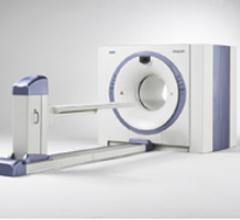
 September 30, 2011
September 30, 2011 



